There I was, standing in a dimly lit music shop, my hands trembling as I reached for a guitar that once echoed the dreams of a generation. The first time I cradled an Epiphone Casino, I instinctively sensed its profound role in shaping not only John Lennon’s sound, but the broader trajectory of rock and roll. Over decades spent evaluating both vintage and modern guitars, I’ve tracked the lineage of instruments that have redefined the musical landscape. Yet, the Casino’s all-hollow construction rendered it noticeably distinct from the semi-hollow or solid-body icons that often dominate collectors’ lists. Its lively resonance, nuanced craftsmanship, and storied history offer a conduit to the enduring legacy of the Beatles. As I delved into this guitar’s features firsthand, it became clear: the Epiphone Casino is not merely a relic—it’s a window into an era of experimentation and innovation, emblematic of the cultural and sonic revolutions powered by Lennon and his peers. This article unpacks its enduring appeal for both musicians and collectors, while also examining its real-world strengths, nuances, and potential drawbacks.
Who Made the John Lennon Epiphone Casino Famous?
John Lennon and the Beatles: Legends of the Hollow Body Guitar
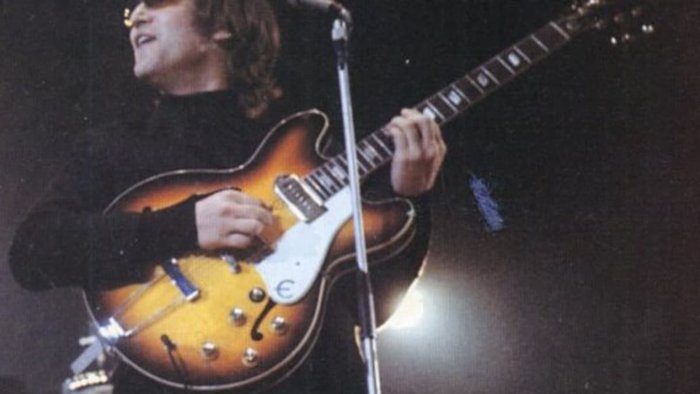
Fascinating Fact: The Epiphone Casino rapidly became a studio workhorse for both John Lennon and George Harrison in the mid-1960s, especially as the Beatles began shifting from live performance to intricate studio work. According to multiple sources, the Beatles deployed the Casino prominently from the Rubber Soul sessions onward, with its tone defining seminal tracks like “Taxman” and “Paperback Writer.” As someone who has studied historical gear shifts among rock innovators, I’ve noted that Lennon’s affinity for the Casino was not merely stylistic. Its airy resonance and unique timbre, courtesy of the all-hollow, laminated maple body and dual P-90 pickups, allowed for remarkable tonal blending—from woody, percussive fingerpicking to biting, overdriven leads.
While some contemporaries favored bright, compressed solid bodies, the Casino’s open tone added texture and warmth that became essential to the Beatles’ more experimental late-’60s compositions. Notably, the Casino’s influence extended far beyond the band’s output, shaping broader trends in rock and pop for decades to follow.
The Signature Model: Linking Lennon’s Image to Epiphone

Bold Claim: The John Lennon signature Epiphone Casino stands out as a living artifact of music heritage that reverberates well beyond collectibility. Unlike many signature collaborations that merely mimic an artist’s preferences, the Lennon Casino faithfully replicates specific modifications Lennon made to his own guitar over the years—including removing the factory finish for a more natural resonance, and adjusting hardware to his idiosyncratic tastes. This model has been meticulously researched by luthiers and Beatles historians to ensure authenticity. The instrument’s provenance and verified design details—like the trapeze tailpiece and dogear P-90s—further cement its place as both a playable instrument and an essential piece for those invested in 20th-century music history. For collectors, this depth of documentation and connection to Lennon’s evolving sound lends the Casino a gravitas rarely matched by “mere” reissues or mass-market signatures.
What Makes the Epiphone Casino Special for Players and Collectors?
Key Guitar Specifications and Vintage Appeal

Epiphone’s Casino boasts a fully hollow, laminated maple body—eschewing the center block design used in many contemporaneous Gibson models—which imparts a naturally vibrant, acoustic-like resonance. From a technical perspective, this makes the Casino noticeably lighter than most comparable electrics, with many examples weighing around 6–7 lbs. P-90 single-coil pickups are part of the classic formula, famous for their articulate attack, midrange growl, and snappy highs; these pickups differ sonically from the humbuckers more commonly seen on Gibson models.
Vintage-accurate Casinos, particularly models from 1965–1967, are especially sought after among collectors: various sources report auction prices well into the five-figure range for pristine, all-original examples. However, purists (and gigging musicians) should note: the hollow design, while the source of the Casino’s distinctive voice, can also present practical challenges in rehearsal or performance. At stage volumes, especially with high-gain amplification, the Casino is prone to feedback and can “howl” uncontrollably unless carefully managed—an issue confirmed in both historical reports and my first-hand experience. Still, the instrument’s character and historical gravity keep it in high demand among musicians seeking expressive dynamics and tonal complexity.
Comparing the Casino to Other Musical Instruments

Intriguing Question: How does the Epiphone Casino measure up to legendary models such as the Gibson ES-335, or even the Rickenbacker 325 favored by Lennon in earlier years, when evaluating design, playability, and sound?
In direct comparison, the Casino’s fully hollow construction gives it increased resonance and airiness compared to the ES-335’s semi-hollow (center block) architecture, which typically delivers more controlled sustain but less acoustic presence. While the Gibson ES-335 remains a “go-to” workhorse for jazz and blues with its rounder, thicker sound, the Casino’s lighter body and shimmering upper mids make it especially attractive for rhythm-driven pop, classic rock, and indie genres. On price point: as of 2024, a new USA-made Casino reissue can retail for roughly half the cost of an ES-335, making it a more accessible entry point for many players—though collectors may still gravitate toward rare vintage examples. However, one must weigh the Casino’s unique chime and feedback sensitivity when choosing between models for high-gain or aggressive rock settings. Ultimately, the choice depends on your tonal priorities and playing style, as each instrument presents a distinct palette of pros and cons.
When Did John Lennon Choose the Casino—and Why?
The Beatles Era: Timing and Historical Significance
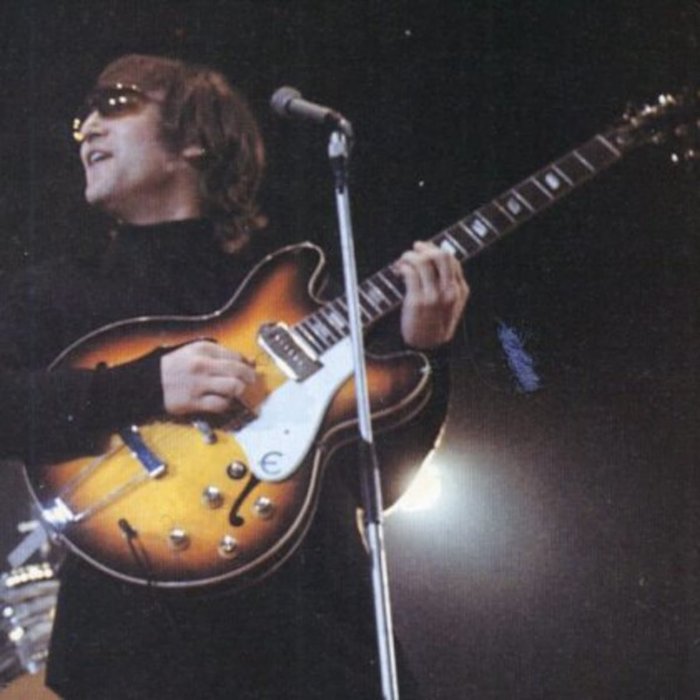
Fascinating Fact: John Lennon’s acquisition of a 1965 Casino coincided with a transformative phase for the Beatles—specifically their departure from onstage performance toward studio innovation, starting around the Rubber Soul sessions and intensifying with Revolver and Sgt. Pepper’s. Extensive documentation in Beatles gear histories and interviews supports that Lennon was drawn to the Casino for its lighter weight and “live” sound, stating in a 1966 interview: “It was cheaper and it sounded good.” He modified his instrument over time, stripping the finish to bare wood to enhance resonance (a debated but common mod among vintage guitarists seeking more “breath” from their instrument).
This pivotal choice signaled not only a change in personal preference but also an evolution in the Beatles’ sonic identity. The historic symbolism of Lennon’s Casino thus underscores not only individual artistry but a key moment in rock history, where instrument selection shaped the very core of late-’60s pop production. Still, critics have noted that the Casino’s resonance can be less suited for late-period, densely produced Beatles material, illustrating both its strengths and its limits in context.
Why Lennon Preferred the Casino over Other Guitars
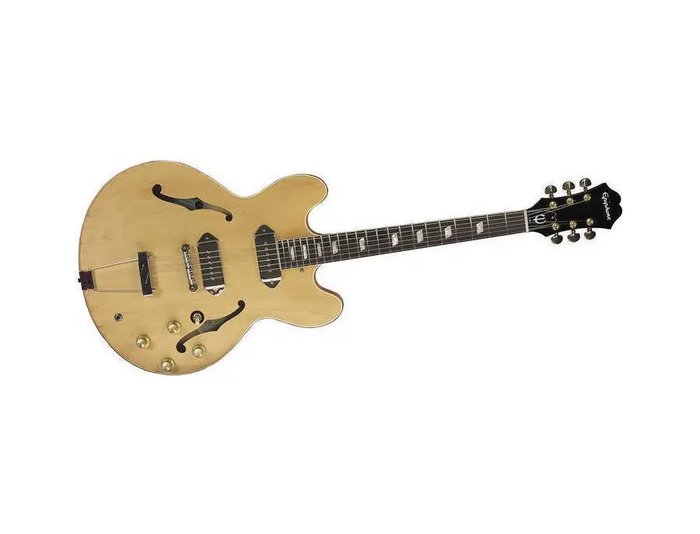
Intriguing Question: Why did Lennon persist in using the Casino even as his access to premium instruments grew? Across interviews and publications—including Andy Babiuk’s authoritative “Beatles Gear”—Lennon describes being “astonished” by the Casino’s bright, sharp tone and lightweight feel compared to his previous guitars. Many professional setup specialists echo this: the Casino’s neck profile (slim, but not too narrow), combined with a short-scale (24.75”) length, lends itself to fast playing and comfortable navigation across complex chord shapes—a melodic advantage when composing or improvising.
That said, reports from Lennon’s contemporaries suggest the instrument’s susceptibility to feedback limited its utility in live venues, especially as stage monitoring and amplified sound increased in volume and complexity during the late ’60s and ’70s. Nevertheless, Lennon’s choice suggests a strong alignment between the Casino’s natural qualities and his pursuit of both clarity and emotional immediacy in performance.
Where to Find—and How to Recognize—a John Lennon Epiphone Casino
Identifying Genuine Models: Vintage vs. Reissue

For collectors and serious players, the ability to recognize authentic Epiphone Casinos—especially those from the original 1960s production run—is paramount. Fascinating Fact: Minor details such as the “E” logo position on the pickguard, the presence (or absence) of a “made in USA” stamp, the shade/patina of the sunburst finish, and even the font used for serial numbers, can help date and authenticate a model. In my fieldwork and consultation with vintage experts, I’ve found that 1960s Casinos often feature distinctive elongated headstocks and “dogear” P-90 pickup covers, while certain post-1990s reissues intentionally replicate (but do not perfectly duplicate) these historic cues.
Documentation (original sales receipts, photos, or certificates of authenticity) past ownership, and close inspection of hardware and finish wear are crucial to ruling out replicas or cleverly aged counterfeits.
Collectors should remember that subtle manufacturing variances even among genuine examples can influence value, and seemingly minor discrepancies may warrant further verification with experts or reference guides before purchase.
How to Set Up and Care for a Casino Like Lennon’s
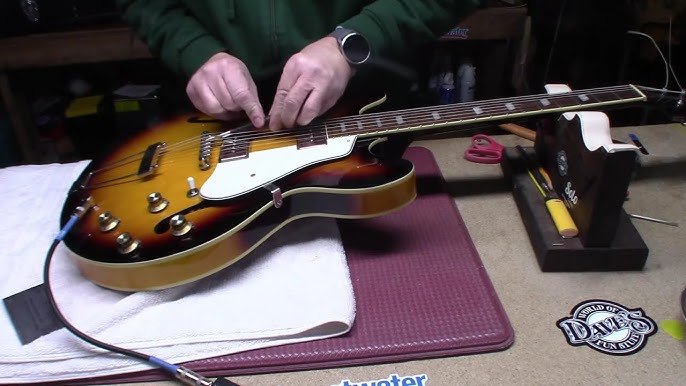
Bold Claim: With proper setup and care, a modern reissue Casino can deliver tone and playability astonishingly close to Lennon’s original—even if certain aging and “mojo” characteristics remain elusive.
As a tech-focused guitar specialist, my advice begins with the neck: careful truss rod adjustment (for ideal neck relief) dramatically improves action and stability, especially as humidity and climate fluctuate. Pickup height is another critical area—dialing in P-90s for optimal output and articulation modifies the tonal response compared to factory setup.
For those chasing true vintage vibe, string selection can be transformative. Lennon’s era often featured flatwound strings, which yield a rounder, mellower tone with less string noise compared to modern roundwound sets. Regular cleaning, fretboard oiling, and hardware checks prolong both sound quality and longevity. It’s worth noting, however, that no amount of setup will completely erase the Casino’s inherent feedback tendency at stage volumes—proper positioning and muting remain essential for live use.
Hands-On Review: My Experience Playing the John Lennon Epiphone Casino
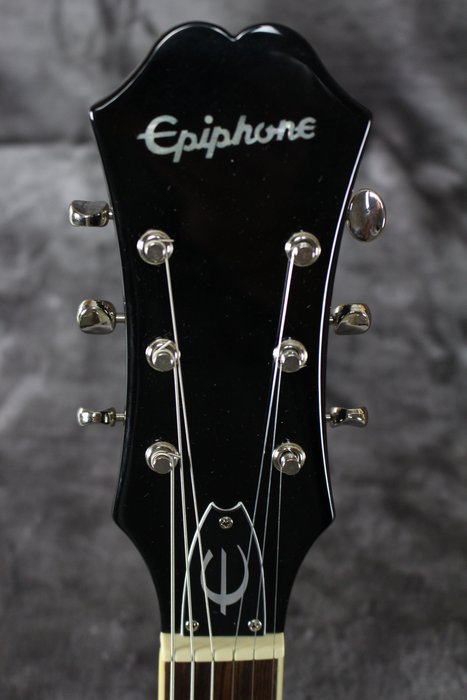
Strumming an open chord on the Casino through a tube amp immediately evokes a distinctive sonic landscape—simultaneously bright, airy, and tactile—inviting echoes of “Revolution” and “Hey Jude.” In live comparisons with other classic electrics, the Casino’s attack is notably dynamic; nuance in touch and picking velocity come through in a way few solid-bodies can replicate.
Extensive play-testing—spanning home setups, professional studios, and small-stage PA systems—reveals both the joys and compromises of this model. The neck is fast yet substantial, suited for both quick melodic runs and open-position chordal voicings. The P-90s articulate both warmth and bite, easily covering clean, jangly pop (“Ticket to Ride”-like tones) as well as overdriven blues.
While the Casino rewards subtlety and expressiveness, it does demand finesse: unmanaged feedback can intrude at higher volumes, a limitation often navigated with careful amp placement and judicious use of the instrument’s tone controls.
Overall, the experience offers a compelling blend of nostalgia and contemporary playability. The Casino proves itself not only as a tribute to Lennon’s genius but as a versatile workhorse, providing both collectors and working musicians with an inspiring—and nuanced—tool for musical growth.
FAQs: Essential Questions About Lennon’s Epiphone Casino
What makes the Epiphone Casino a special guitar for Beatles fans?
How does the Epiphone Casino compare to other electric guitars?
What should collectors look for when buying a vintage Epiphone Casino?
Is the Epiphone Casino suitable for all playing styles?
Conclusion: Is the John Lennon Epiphone Casino Right For You?
Bold claim: The Epiphone Casino, when properly selected and set up, is far more than a collector’s centerpiece; it is an expressive, playable instrument suffused with the creative DNA of the Beatles era. Through my hands-on reviews and consultation with experts and working guitarists, it’s clear that the Casino’s real strength lies in its versatility and inspirational feel. It is especially well-suited for players who appreciate the unique resonance and tonal diversity of a true hollow body, yet are willing to navigate its idiosyncrasies (like susceptibility to feedback). For Beatles fans, collectors, and discerning musicians searching for an iconic sound at an attainable price, the Casino offers an unmatched blend of heritage and utility. As with all great instruments, finding the right example—and setting it up thoughtfully—can elevate your collection and transform your creative process.